Last May, I traveled with fellow curator Diana N’Diaye to Armenia to conduct workshops as part of our My Armenia project. Since the initial topic of research was food traditions, we spent quite a bit of time sampling the local cuisine (for further research, of course). I am still carrying around the extra five pounds I gained on the trip, along with the memory of the delicious dishes we tried and some of the related cultural misunderstandings that ensued.
On a low table in the backyard of a home in Voskevaz, Armenia, lay a plate of dried fruit confections. We were invited to help ourselves. As I tried a dried peach stuffed with sugar, walnuts, and spices and a sort of homemade Fruit Roll-Up also stuffed with walnuts, one of the My Armenia research fellows, Harutyun Marutyan, commented that the dish was jokingly called “Armenian sneakers.” That’s what I heard at least.
We had come to Voskevaz for a day of fieldwork after our first workshop discussing research techniques on foodways and related Armenian traditions. My Armenia is multifaceted, with the ultimate task of increasing cultural tourism in the country and possibly contributing to a future Smithsonian Folklife Festival program. The research fellows, all native Armenians and trained ethnographers, will be documenting foodways this summer in the province of Vayots Dzor, south of the capital of Yerevan.
Further north, Voskevaz is a community settled many generations ago by Iranian Armenians. Since the collapse of the Soviet era, when it and other rural villages were divided into cooperative farms, farmers have developed a lucrative strawberry industry.
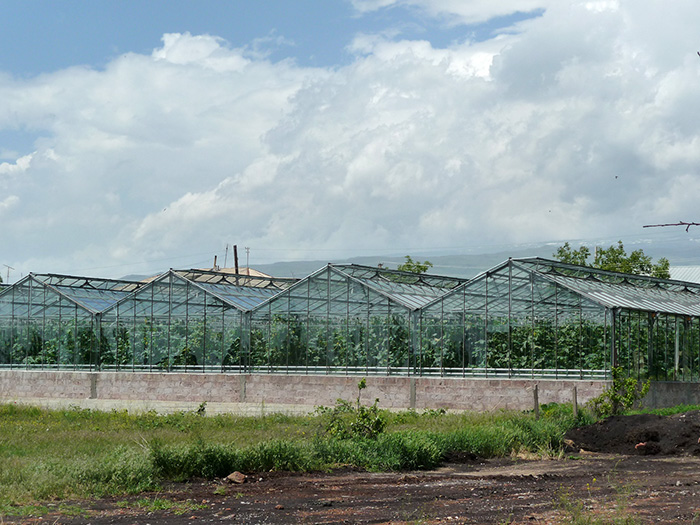
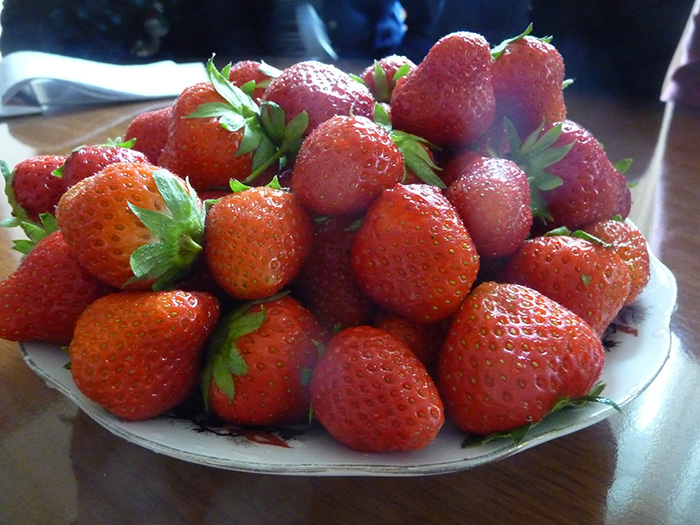
During a meeting with the mayor in the town hall, we were served mounds of fresh strawberries and strong Armenian coffee. A complex discussion of traditions in the village ensued, all in Armenian, with sporadic English translation for us Americans.
We visited home after home, sampling homemade wine and vodka, admiring gardens, enjoying strawberries straight from the vine and lavash hot from the oven, and always asking questions. We toured wine cellars, outdoor kitchens, home workshops, back gardens with beehives and bird pens.
By the time we reached the fifth house, where we were treated to salt-preserved fish and pickled vegetables, more dried fruit confections, and more homemade alcoholic beverages, you could see the wear on our faces. We agreed to visit one last home, the mayor’s, before we bid our village guides goodbye.
To my surprise, there were preparations for a whole barbecue meal (khorovats in Armenian) awaiting us. The barbecue crew was taking a batch of pork out of its fragrant tub of marinade and stringing it on long metal rods to be placed over a fire made of dried grape vines. How could we say no to a barbecue in our honor, the highest form of hospitality?
The meat preparation proceeded outdoors while the assembly of tomato and cucumber salad began indoors. As the only English-only speaker left at that point, I wandered and took photos throughout the festivities and in the storage room, hung with honeycomb and shelves heavy with canned vegetables and preserved fruit. I was treated to the first meat off the grill (usually reserved for the men tending the barbecue), accompanied by a liberal dose of vodka and an obligatory toast.
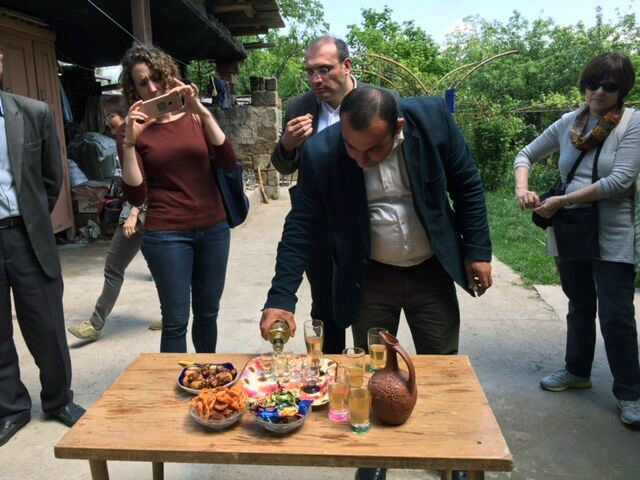
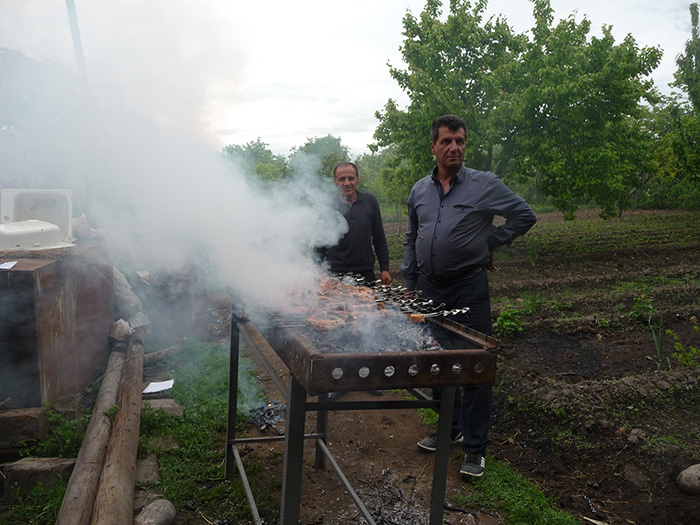
The table was laden with salads, lavash, and piles of scrumptious barbecued meat. The biggest chop was served onto my plate. I was well into polishing off the huge hunk of meat when the music began, courtesy of the grill masters who also brought along their instruments.
Despite being flanked by a research fellow on one side and a project staff member on the other who were valiantly trying to keep up the translation for me, I had very little idea of the nuances of what was going on. I was just happy to be there, eating a home-cooked meal in the company of villagers and researchers laughing and singing. In an attempt to find some common ground, the accordion player serenaded me with an Italian song and then broke into “Happy Birthday” (in Armenian, but with the familiar American tune).
By the time we finally left, most of us could barely stand. At the next morning’s workshop we were a little worse for the wear but ready to debrief our day in the field and the connections we made in the village.
When I explained the story about the Armenian sneakers, everyone laughed, especially Harutyun. Turns out he was saying Armenian Snickers which made a lot more sense. I had misunderstood his accent. I wondered how many other cultural disconnects had occurred during our day in Voskevaz. Clearly the language barrier and my lack of understanding of cultural nuances caused me to miss, and misunderstand, a great deal.
I knew I had learned much during our day in the village. Tasting homemade food and wine, seeing people’s homes, and feeling the warmth of their hospitality was, for me, as important as understanding their words. Still, Snickers versus sneakers is a pretty big leap. As funny as it was, it was humbling to discover my mistake.
The moral of the story for me is, even in the midst of making cultural connections, beware the disconnects as well, and always ask questions. You will never know everything about another culture, but you will experience it on many levels if you keep your eyes and ears open. And, eventually, you might figure out the difference between a candy bar and footwear.
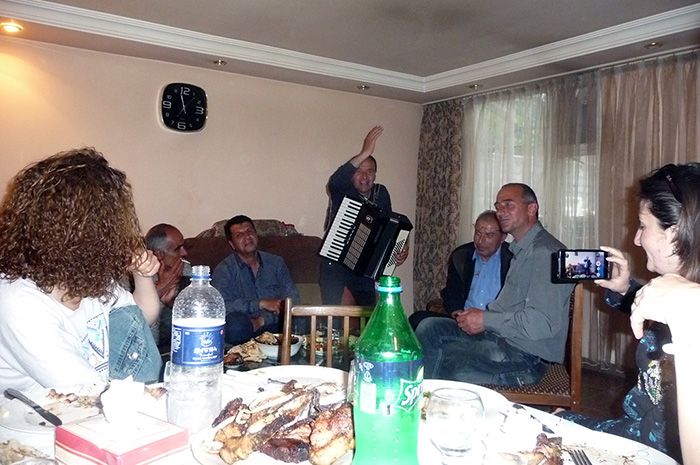
Betty Belanus is a curator and education specialist at the Center for Folklife and Cultural Heritage. She tries to use all her senses when doing fieldwork, but apparently needs to be more attentive in the hearing department.


